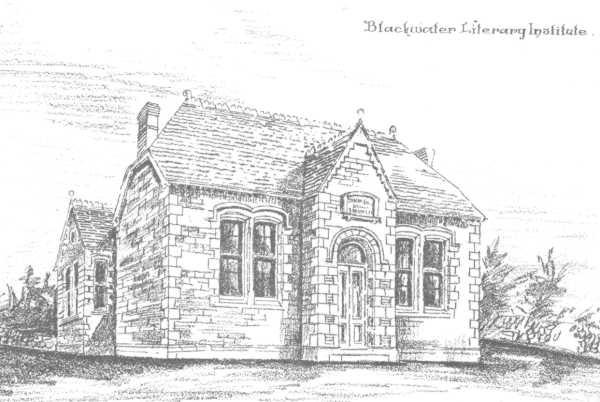Passmore Edwards referred to his first 3 public buildings in Cornwall as “The Three Sisters”. As his generosity increased they became the “Seven Sisters in Stone”. By 1900 there were 20 such buildings within Cornwall bearing his name and a further one in Devon.
The honour of receiving Passmore Edward’s first bequest fell to his home village of Blackwater, in Cornwall. The Vicar of Mithian wrote to Edwards asking for a few books for a little reading club he had started in the village. His response was a gift of not only 500 books but the Institute building in which to house them.

The Rev C F Rogers was appointed to the parish of Mithian in 1898. On acquainting himself with the people of the Parish he considered that one of his priorities was to supplement in some way the education given in the Board and other day schools. He said that it was a great pity that the education of young people ended when they left school and that there was nowhere, especially in rural communities, where they could use the assets they had acquired. He therefore set out to establish a reading room or institute where he could get more to know his parishioners as they organised and attended lectures and meetings and made use of what books they could acquire. Initially, he rented a small two roomed cottage and collected together a number of books. It was then that Mr W S Hooper and Mr W Symons spoke to him about Passmore Edwards and the assistance he had given to a number of local institutes and the fact that he funded an annual get together and meal for the old people of Blackwater. Rev Rogers wrote to Passmore Edwards for assistance in purchasing books for the institute and was surprised to receive a swift and positive response from him. Edwards said that if the Institute was to be managed by the people for the public good, and was not to be in any way sectarian, he would not only help, but would build an institute at his own expense. This was entirely in keeping with the Reverends views, although some parishioners did not agree with him on the criteria relating to religion, and he set about realising this generous offer.
Although Passmore Edwards was not able to attend the opening ceremony, on 7 August 1890, his thoughts were clearly with the crowd that assembled around the tiny institute building to witness the Rev Rogers declare the building open.
The building is constructed only a hundred yards or so from where the cottage where Edwards was born once stood. Built of local stone, the gift of the Tywarnhale Estate, on land donated by Lord Falmouth, the building was designed by John Symons, Edwards’s former school friend, and his son, Frank. The masonry work was carried out by James Prowse & Son and the decoration by Solomon & Co and Mr Craze. Internal furnishing was carried out by J Symons & Son. Internally the Institute contained two main wooden panelled rooms with a central wooden divider which could be removed to enable village functions to take place as was the case that first evening when a concert was held. This was well attended and consisted of a programme of music and recitations. The continued good use of the institute, which was for the use of all residents of Balckwater, both male and female, was reported in the West Briton of 29 January 1891 following a programme of “musical and dramatical entertainment on Saturday 17/1/91 at the Blackwater institute; ” when “not withstanding the severe weather the room was full to excess.
The Institute was also the site for the Dairy School classes undertaken by the County Technical Instruction Committee.
According to Tony Mansell and Clive Benney (A history of Blackwater and its neighbours) in 1920 the Institute was the scene of a Coroners inquest into a double murder. Laura Sara and Joseph Hoare were bludgeoned to death at their home near Blackwater. The case remained unsolved.
Although the WI used the building for some years from about 1954 the use became increasingly that of a “men’s snooker club. Unfortunately, over the years the Institute fell into disrepair and closed. As the last secretary to the Trustees, Charlie Palmer arranged for emergency repairs to be carried out on numerous occasions but by 2007 the building was semi derelict.